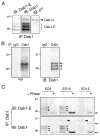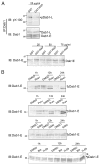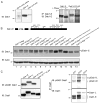Serine phosphorylation regulates disabled-1 early isoform turnover independently of Reelin
- PMID: 21111810
- PMCID: PMC3723522
- DOI: 10.1016/j.cellsig.2010.11.007
Serine phosphorylation regulates disabled-1 early isoform turnover independently of Reelin
Abstract
The Reelin-Disabled 1 (Dab1) signaling pathway plays an important role in neuronal cell migration during brain development. Dab1, an intracellular adapter protein which is tyrosine phosphorylated upon Reelin stimulation, has been directly implicated in the transmission and termination of Reelin-mediated signaling. Two main forms of Dab1 have been identified in the developing chick retina, an early isoform (Dab1-E) expressed in progenitor cells and a late isoform (Dab1-L, a.k.a. Dab1) expressed in differentiated cells. Dab1-E is missing two Src family kinase (SFK) phosphorylation sites that are critical for Reelin-Dab1 signaling and is not tyrosine phosphorylated. We have recently demonstrated a role for Dab1-E in the maintenance of retinal progenitor cells. Here, we report that Dab1-E is phosphorylated at serine/threonine residues independent of Reelin. Cdk2, highly expressed in retinal progenitor cells, mediates Dab1-E phosphorylation at serine 475 which in turn promotes ubiquitination-triggered proteasome degradation of Dab1-E. Inhibition of protein phosphatase 1 and/or protein phosphatase 2A leads to increased Dab1-E instability. We propose that Dab1 turnover is regulated by both Reelin-independent serine/threonine phosphorylation and Reelin-dependent tyrosine phosphorylation.
Copyright © 2010 Elsevier Inc. All rights reserved.
Figures








Similar articles
-
The early isoform of disabled-1 functions independently of Reelin-mediated tyrosine phosphorylation in chick retina.Mol Cell Biol. 2010 Sep;30(17):4339-53. doi: 10.1128/MCB.00545-10. Epub 2010 Jul 6. Mol Cell Biol. 2010. PMID: 20606009 Free PMC article.
-
Modulation of Reelin signaling by Cyclin-dependent kinase 5.Brain Res. 2007 Apr 6;1140:84-95. doi: 10.1016/j.brainres.2006.01.121. Epub 2006 Mar 10. Brain Res. 2007. PMID: 16529723
-
Hierarchical disabled-1 tyrosine phosphorylation in Src family kinase activation and neurite formation.J Mol Biol. 2007 Apr 27;368(2):349-64. doi: 10.1016/j.jmb.2007.01.068. Epub 2007 Feb 3. J Mol Biol. 2007. PMID: 17350651 Free PMC article.
-
Reelin-Disabled-1 signaling in neuronal migration: splicing takes the stage.Cell Mol Life Sci. 2013 Jul;70(13):2319-29. doi: 10.1007/s00018-012-1171-6. Epub 2012 Sep 28. Cell Mol Life Sci. 2013. PMID: 23052211 Free PMC article. Review.
-
Nonneuronal roles for the reelin signaling pathway.Dev Dyn. 2017 Apr;246(4):217-226. doi: 10.1002/dvdy.24462. Epub 2016 Nov 17. Dev Dyn. 2017. PMID: 27739126 Review.
Cited by
-
Application of Human Stem Cell Derived Retinal Organoids in the Exploration of the Mechanisms of Early Retinal Development.Stem Cell Rev Rep. 2023 Aug;19(6):1755-1772. doi: 10.1007/s12015-023-10553-x. Epub 2023 Jun 3. Stem Cell Rev Rep. 2023. PMID: 37269529 Review.
-
Splice-mediated motif switching regulates disabled-1 phosphorylation and SH2 domain interactions.Mol Cell Biol. 2012 Jul;32(14):2794-808. doi: 10.1128/MCB.00570-12. Epub 2012 May 14. Mol Cell Biol. 2012. PMID: 22586277 Free PMC article.
-
Dab1 (Disable homolog-1) reelin adaptor protein is overexpressed in the olfactory bulb at early postnatal stages.PLoS One. 2011;6(10):e26673. doi: 10.1371/journal.pone.0026673. Epub 2011 Oct 25. PLoS One. 2011. PMID: 22046330 Free PMC article.
-
Disabled-1 alternative splicing in human fetal retina and neural tumors.PLoS One. 2011;6(12):e28579. doi: 10.1371/journal.pone.0028579. Epub 2011 Dec 6. PLoS One. 2011. PMID: 22163036 Free PMC article.
References
-
- Howell BW, Hawkes R, Soriano P, Cooper JA. Nature. 1997;389(6652):733. - PubMed
-
- Trommsdorff M, Borg JP, Margolis B, Herz J. J Biol Chem. 1998;273(50):33556. - PubMed
-
- Songyang Z, Shoelson SE, Chaudhuri M, Gish G, Pawson T, Haser WG, King F, Roberts T, Ratnofsky S, Lechleider RJ, et al. Cell. 1993;72(5):767. - PubMed
Publication types
MeSH terms
Substances
Grants and funding
LinkOut - more resources
Full Text Sources
Molecular Biology Databases
Research Materials
Miscellaneous

